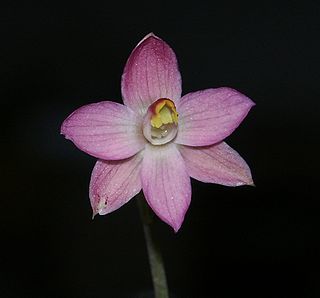
Thelymitra rubra, commonly called the salmon sun orchid or pink sun orchid, is a species of orchid endemic to southeastern Australia. It has a single thin, grass-like leaf and up to five salmon pink flowers with broad, toothed arms on the sides of the column. It is similar to T. carnea but the flowers are larger and the column arms are a different shape.
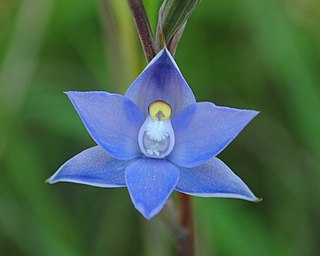
Thelymitra nuda, commonly known as the plain sun orchid is a species of orchid that is endemic to eastern Australia. It has a single fleshy, channelled leaf and up to twelve dark blue to purplish, sometimes white or pinkish flowers with white tufts on top of the anther. It grows in a range of habitats and sometimes forms large colonies.

Thelymitra aristata, commonly called the great sun orchid, is a species of orchid that is endemic to south-eastern Australia. It has a single large, thick leaf and bracts and up to forty crowded blue or purplish flowers with darker veins.
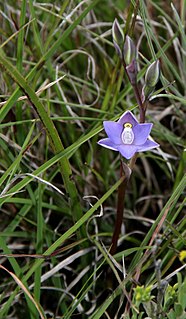
Thelymitra gregaria, commonly called the clumping sun orchid, is a species of orchid that is endemic to Victoria. It has a single fleshy, channelled leaf and up to six strongly scented, dark blue to purple flowers and often grows in clumps.
Thelymitra imbricata, commonly called the broad sun orchid, is a species of orchid that is endemic to Tasmania. It has a single erect, channelled leaf and up to fifteen or more pale to dark or purplish blue, relatively large flowers.
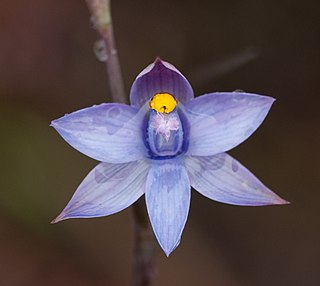
Thelymitra malvina, commonly called the mauve-tufted sun orchid, is a species of orchid that is native to eastern Australia and New Zealand. It has a single large, fleshy leaf and up to twenty five blue to mauve flowers with pink or mauve tufts on top of the anther.
Thelymitra exigua, commonly called the short sun orchid, is a species of orchid that is endemic to south-eastern Australia. It has a single fleshy, channelled, dark green leaf and up to eight relatively small pale blue flowers with white toothbrush-like tufts on top of the anther.

Thelymitra holmesii, commonly called the blue star sun orchid, is a species of orchid that is endemic to south-eastern Australia. It has a single long, narrow, fleshy leaf and up to nine purplish blue to mauve flowers with a deeply notched lobe on top of the anther.
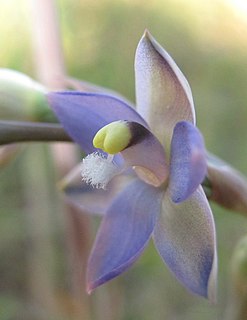
Thelymitra peniculata, commonly called the trim sun orchid, is a species of orchid that is endemic to southern eastern Australia. It has a single long, erect, fleshy, channelled leaf and up to eighteen deep blue to purple self-pollinating flowers.
Thelymitra inflata, commonly called the inflated sun orchid, is a species of orchid that is endemic to south eastern Australia. It has a single long, erect, linear leaf and up to six dark blue to purplish flowers with a very inflated lobe on top of the anther.
Thelymitra lucida, commonly called the glistening sun orchid, is a species of orchid that is endemic to south eastern Australia. It has a single erect, fleshy leaf and up to seven dark blue flowers with the sepals a lighter blue than the petals.
Thelymitra polychroma, commonly called the rainbow sun orchid, is a species of orchid that is endemic to Tasmania. It has a single narrow, fleshy leaf and up to four blue and mauve flowers with darker veins. It grows in windswept heath and swampy areas and the flowers are self-pollinated.
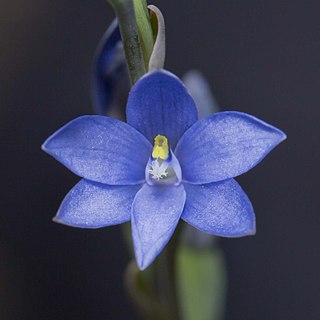
Thelymitra longiloba, commonly called the lobed sun orchid, is a species of orchid that is endemic to south-eastern Australia. It has a single erect, fleshy, channelled leaf and up to six relatively small blue flowers with side lobes above the anther. Although widespread, it only occurs in disjunct populations and is classed as "endangered".
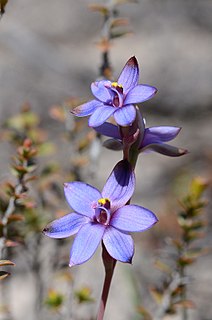
Thelymitra azurea, commonly called the azure sun orchid, is a species of orchid that is endemic to south-eastern Australia. It has a single fleshy, grass-like leaf and up to ten dark azure blue flowers with darker veins. The lobe on top of the anther has a toothed or warty tip.
Thelymitra jonesii, commonly called the skyblue sun orchid, is a species of orchid that is endemic to Tasmania. It has a single erect, fleshy, linear, dark green leaf and up to six relatively small light blue to azure blue flowers with darker veins. It is a rare orchid known from only four scattered locations in moist coastal heath.
Thelymitra latiloba, commonly called the wandoo sun orchid or wandoo shirt orchid, is a species of orchid in the family Orchidaceae and endemic to the south-west of Western Australia. It has a single erect, fleshy, channelled, dark green leaf and up to twelve blue flowers with darker blue veins and sometimes flushed with mauve. The lobe on top of the anther is wavy.
Thelymitra occidentalis, commonly called the western azure sun orchid or rimmed orchid, is a species of orchid in the family Orchidaceae and is endemic to the south-west of Australia. It has a single erect, fleshy, channelled, dark green leaf and up to fifteen blue flowers with darker blue veins and sometimes flushed with pink. The lobe on top of the anther has a wavy, yellow crest.
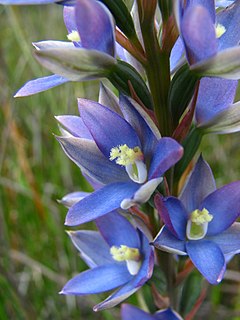
Thelymitra circumsepta, commonly called the naked sun orchid, is a species of orchid that is endemic to south-eastern Australia. It has a single leathery, dark green leaf and up to twenty blue to purplish or pink flowers with fringed lobes and yellowish hair tufts on top of the column.
Thelymitra incurva, commonly called the coastal striped sun orchid, is a species of orchid that is endemic to south-eastern Australia. It has a single erect, dark green grass-like leaf and up to seven relatively large, pale blue flowers lacking the darker veins of some other thelymitras, especially the otherwise similar striped sun orchid. It grows in coastal areas of far south-eastern New South Wales and north-eastern Victoria.

Thelymitra pulchella, commonly called the striped sun orchid, is a species of orchid in the family Orchidaceae that is endemic to New Zealand. It has a single erect, fleshy, channelled leaf and up to fourteen blue flowers with darker stripes on the petal and sometimes also on the sepals. The column and its lobes are variable in shape and colour.










